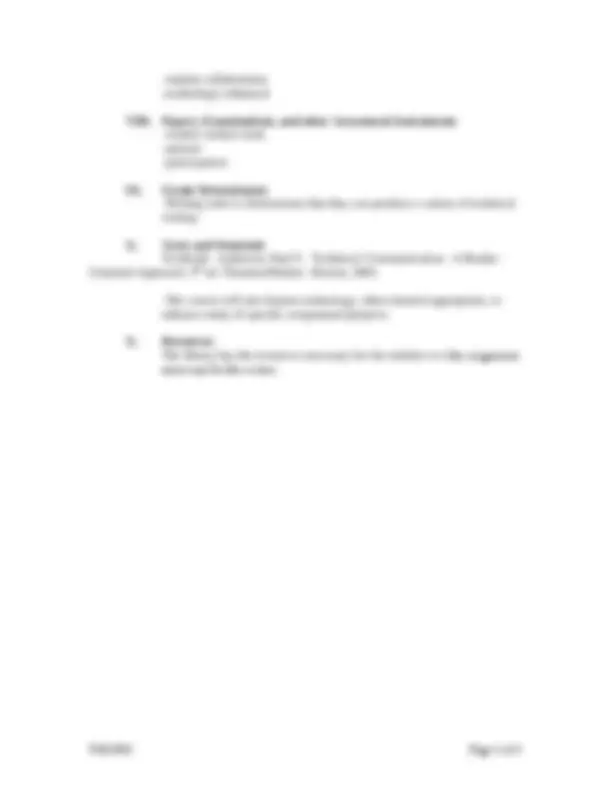



Study with the several resources on Docsity

Earn points by helping other students or get them with a premium plan


Prepare for your exams
Study with the several resources on Docsity

Earn points to download
Earn points by helping other students or get them with a premium plan
Community
Ask the community for help and clear up your study doubts
Discover the best universities in your country according to Docsity users
Free resources
Download our free guides on studying techniques, anxiety management strategies, and thesis advice from Docsity tutors
Material Type: Lab; Class: TECH WRITING AND COMMUNICATION; Subject: English; University: Raritan Valley Community College; Term: Fall 2003;
Typology: Lab Reports
1 / 3

This page cannot be seen from the preview
Don't miss anything!


Raritan Valley Community College
NEW COURSE PROPOSAL
I. Basic Course Information
A. Course Number and Title: Technical Writing and Communication, ENGL- B. Date of Proposal: November, 2003 C. Sponsoring Department: English D. Semester Credit Hours: 3 E. Weekly Contact Hours: 3 F. Prerequisites: English I G. Laboratory Fees: None
II. Catalogue Description Prerequisite: English I Technical Writing and Communication is designed for students majoring in science, engineering, or other technical fields. The course will provide students with an overview of the technical writing and communication field and students will complete assignments that reflect the kinds of writing tasks they will be expected to perform in their fields.
III. Statement of Course Need
Technical Writing and Communication satisfies the need of a growing population of students who wish to major in the science and engineering field. Technical Writing and Communication will offer interested students the opportunity for more in-depth study of the types of writing and communication they will need in the technical field. Research reveals that many two-year and four-year institutions in New Jersey have equivalent courses to the one proposed, ensuring successful transferability for students.
IV. Place of Course in College Curriculum
A. Technical Writing is required for the Electric Utility Technology program and the Biotechnology Certificate program. B. Course Transferability: As stated in “Statement of Course Need,” Technical Writing and Communication will readily transfer to four-year institutions which have an equivalent course in place, and will be enhance the professional careers of those entering or already in a position in the workforce.
V. Course Content
Students will study the following technical writing skills:
--appropriate approaches to correspondence, including drafting letters, memos, e- mails, together with development of an effective technical style, including aspects of revising, editing, and proofreading; --approaches to visual elements, such as graphics, charts, graphs (i.e., putting data or words into graphics, or, putting graphics into words); --approaches to graphic design, including layout of pages and web screens; --approaches to oral presentations, including the use of supportive visuals; --approaches to team collaboration on varied types of technical writing projects, including writing varied types of reports (i.e., empirical research report, feasibility report, progress report, proposals, varied types of instructional or procedural manuals, and web pages)
VI. Educational Goals and Learning Outcomes Goals: Students will a. demonstrate effective technical writing skills in a varied forms (G. E. 1, G. E. 2); b. develop a broad knowledge of the various types of effective technical writing and communication mechanisms (G. E. 1, G. E. 2, G. E. 3); c. develop an ability to collaborate effectively on team writing projects (G. E. 1, G. E. 2, G. E. 3); d. demonstrate proficient use of electronic database resources in researching writing projects and web page development tools (G. E. 3); e. enhance interdisciplinary skills in the fields of science/engineering and utility technology/biotechnology (G. E. 4);
Objectives: The student will be able to: a. produce a variety of technical documentation with technically fluid writing skills, including organization, style and overall coherence; and, b. present varied kinds of reports, graphic, oral, or written in a technically appropriate, collaborative, and organized fashion; c. demonstrate proficiency in quantitative reasoning, including effective interpretation of data into writing and graphics.
VII. Modes of Teaching and Learning -lecture/discussion -small-group work, depending on instructor -guest speakers, depending on instructor -student oral presentations, depending on instructor